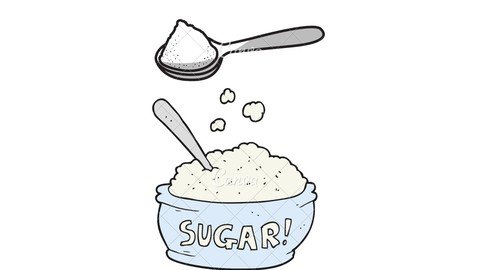

E-Books / Video Training →Udemy - Biomolecule Carbohydrates
Published by: voska89 on 22-11-2022, 23:38 |  0
0

Published 11/2022
MP4 | Video: h264, 1280x720 | Audio: AAC, 44.1 KHz
Language: English | Size: 4.18 GB | Duration: 4h 40m
Biochemistry of Carbohydrate.
Biochemistry of Carbohydrate.
What you'll learn
You will Learn about the Chemical Structure of Carbohydrates.
You will be Able to analyse the Chemical properties of Carbohydrates.
You will Know about the Organic Chemistry of Carbohydrates.
You will learn about the chemical and Biological properties of carbohydrates.
You will learn the Chemical Reactions which include Carbohydrates along with their reaction Mechanism.
Requirements
Basic knowledge of Biology and Chemistry is required.
Description
carbohydrate, class of naturally occurring compounds and derivatives formed from them. In the early part of the 19th century, substances such as wood, starch, and linen were found to be composed mainly of molecules containing atoms of carbon (C), hydrogen (H), and oxygen (O) and to have the general formula C6H12O6; other organic molecules with similar formulas were found to have a similar ratio of hydrogen to oxygen. The general formula Cx(H2O)y is commonly used to represent many carbohydrates, which means "watered carbon."starch granulesCarbohydrates are probably the most abundant and widespread organic substances in nature, and they are essential constituents of all living things. Carbohydrates are formed by green plants from carbon dioxide and water during the process of photosynthesis. Carbohydrates serve as energy sources and as essential structural components in organisms; in addition, part of the structure of nucleic acids, which contain genetic information, consists of carbohydrate.Although a number of classification schemes have been devised for carbohydrates, the division into four major groups—monosaccharides, disaccharides, oligosaccharides, and polysaccharides—used here is among the most common. Most monosaccharides, or simple sugars, are found in grapes, other fruits, and honey. Although they can contain from three to nine carbon atoms, the most common representatives consist of five or six joined together to form a chainlike molecule. Three of the most important simple sugars—glucose (also known as dextrose, grape sugar, and corn sugar), fructose (fruit sugar), and galactose—have the same molecular formula, (C6H12O6), but, because their atoms have different structural arrangements, the sugars have different characteristics; i.e., they are isomers.
Overview
Section 1: Introduction
Lecture 1 Introduction
Section 2: Carbohydrate , Definition and Examples.
Lecture 2 Definition and Examples
Lecture 3 Precised definition of Carbohydrate
Lecture 4 Improved definition of Carbohydrate: Hemiacetal and Hemiketal.
Section 3: Classification, D and L Designation, Mutarotation of Carbohydrates.
Lecture 5 Classification Of Carbohydrates.
Lecture 6 Further classification of Monosaccharides.
Lecture 7 Sugars and Non-Sugars.
Lecture 8 D and L Designation.
Lecture 9 Monosaccharides.
Lecture 10 Examples of Triose, Tetrose, Pentoses and Hexoses.
Lecture 11 Preparation and Physical Properties of Glucose.
Lecture 12 Mutarotation.
Section 4: Further Classification and structure of Carbohydrates and Chemical Properties.
Lecture 13 Chemical reactions of Glucose
Lecture 14 Cyclic Structure of Glucose.
Lecture 15 Cyclic Structure of Fructose.
Lecture 16 Reducing and Non-Reducing Sugars.
Lecture 17 Oligosaccharides
Lecture 18 Polysaccharides.
Section 5: Notes
Lecture 19 Notes
Section 6: Questions
A level and Undergraduate students.
https://www.udemy.com/course/biomolecule-carbohydrates/
Buy Premium From My Links To Get Resumable Support,Max Speed & Support Me
Download From 1DL
https://1dl.net/ep3fr6ag31m9/xgshj.Biomolecule.Carbohydrates..part1.rar.html
https://1dl.net/f0galqkd05b8/xgshj.Biomolecule.Carbohydrates..part5.rar.html
https://1dl.net/jdb9v954xeqb/xgshj.Biomolecule.Carbohydrates..part4.rar.html
https://1dl.net/kzdasksafqsn/xgshj.Biomolecule.Carbohydrates..part3.rar.html
https://1dl.net/v3iyi79xsrrf/xgshj.Biomolecule.Carbohydrates..part2.rar.html

https://rapidgator.net/file/6bb229f1f38f2bba2e45392cb8c994e1/xgshj.Biomolecule.Carbohydrates..part4.rar.html
https://rapidgator.net/file/8af8eace37b149663c26e84f09b3eb8d/xgshj.Biomolecule.Carbohydrates..part3.rar.html
https://rapidgator.net/file/a1415b785653dadaa5d21e20bfa8746d/xgshj.Biomolecule.Carbohydrates..part2.rar.html
https://rapidgator.net/file/a995c41b1b1fa153e237598a381e36f0/xgshj.Biomolecule.Carbohydrates..part5.rar.html
https://rapidgator.net/file/d08361de2cd5910f4c5cff92598306e5/xgshj.Biomolecule.Carbohydrates..part1.rar.html

https://uploadgig.com/file/download/02c87cbfD5bAEd56/xgshj.Biomolecule.Carbohydrates..part2.rar
https://uploadgig.com/file/download/487e629e9d59d142/xgshj.Biomolecule.Carbohydrates..part3.rar
https://uploadgig.com/file/download/c4FD976b876de237/xgshj.Biomolecule.Carbohydrates..part4.rar
https://uploadgig.com/file/download/dd127bdD7c076e58/xgshj.Biomolecule.Carbohydrates..part5.rar
https://uploadgig.com/file/download/f5989e303693e6F6/xgshj.Biomolecule.Carbohydrates..part1.rar

https://nitroflare.com/view/03CDA6679BA3922/xgshj.Biomolecule.Carbohydrates..part1.rar
https://nitroflare.com/view/25DE0CC4A408E6C/xgshj.Biomolecule.Carbohydrates..part2.rar
https://nitroflare.com/view/4982A1B25BA32B9/xgshj.Biomolecule.Carbohydrates..part4.rar
https://nitroflare.com/view/6FF6E8D470592D2/xgshj.Biomolecule.Carbohydrates..part5.rar
https://nitroflare.com/view/7F9A46DE46D671B/xgshj.Biomolecule.Carbohydrates..part3.rar
Links are Interchangeable - No Password - Single Extraction
Related News
-
{related-news}

